Ian Manners
Department of Chemistry, University of Victoria
March 14, 2023
Nanoparticles possess widths ca. 1000 times less than that of human hair and have many potential applications in fields as diverse as electronics to cancer therapy. However, their preparation has posed many challenges to chemists. In this lecture, the creation of polymer-based nanoparticles with a wide variety of uses will be described using a new method termed “crystallization-driven self-assembly” (CDSA). This process involves the use of crystallization to create nanoparticles with different shapes, controlled dimensions, and tailored functions. The CDSA method is attracting growing attention worldwide, and in this lecture, recent work on 1D nanofibers, 2D platelets, and more complex nanoparticles with applications in areas such as light harvesting, catalysis, and biomedicine will be discussed.
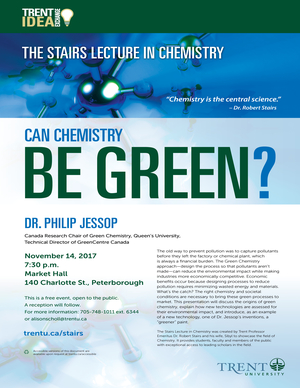
Dr. Philip Jessop
Canada Research Chair of Green Chemistry, Queen's University
Technical Director
November 14, 2017
The old way to prevent pollution was to capture pollutants before they left the factory or chemical plant, which is always a financial burden. The Green Chemistry approach-design the process so that the pollutants aren't made-can reduce the environmental impact while making industries more economically competitive. Economic benefits occur because designing processes to reduce pollution requires minimizing wasted energy and materials. What's the catch? The right chemistry and societal conditions are necessary to bring these green processes to market. This presentation will discuss the origins of green chemistry, explain how new techniques are assessed for their enovironmental impact, and introduce, as an example of new technology, one of Dr Jessop's inventions, a "greener" paint.
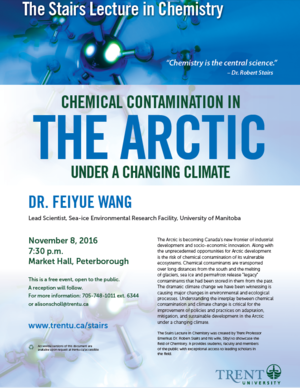
Dr. Feiyue Wang
Lead Scientist, Sea-ice Environmental Research Facility, University of Manitoba
November 8, 2016
The Arctic is Canada’s new frontier of industrial development and socioeconomic innovation. Along with the unprecedented opportunities for Arctic development is the risk of chemical contamination of its vulnerable ecosystems. Chemical contaminants are transported over long distances from the south and the melting of glaciers, sea ice and permafrost release “legacy” contaminants that had been stored in them from the past. The dramatic climate change we have been witnessing is causing major changes in environmental and ecological processes. Understanding the interplay between chemical contamination and climate change is critical for the improvement of policies and practices on adaptation, mitigation, and sustainable development in the Arctic under a changing climate.
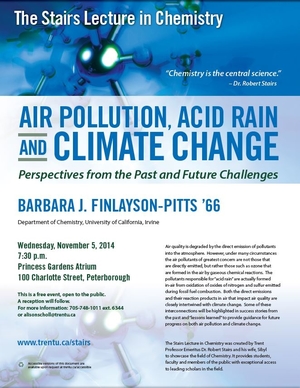
BARBARA J. FINLAYSON-PITTS '66
Department of Chemistry, University of California, Irvine
November 5, 2014
Air quality is degraded by the direct emission of pollutants into the atmosphere. However, under many circumstances the air pollutants of greatest concern are not those that are directly emitted, but rather those such as ozone that are formed in the air by gaseous chemical reactions. The pollutants responsible for “acid rain” are actually formed in-air from oxidation of oxides of nitrogen and sulfur emitted during fossil fuel combustion. Both the direct emissions and their reaction products in air that impact air quality are closely intertwined with climate change. Some of these interconnections will be highlighted in success stories from the past and “lessons learned” to provide guidance for future progress on both air pollution and climate change.
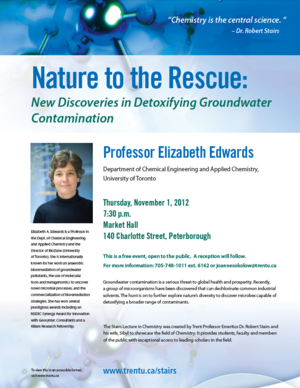
PROFESSOR ELIZABETH Edwards
Department of Chemical Engineering & Applied Chemistry, University of Toronto
November 1, 2012
Groundwater contamination is a serious threat to global health and prosperity. Recently, a group of microorganisms have been discovered that can dechlorinate common industrial solvents. The hunt is on to further explore nature’s diversity to discover microbes capable of detoxifying a broader range of contaminants.
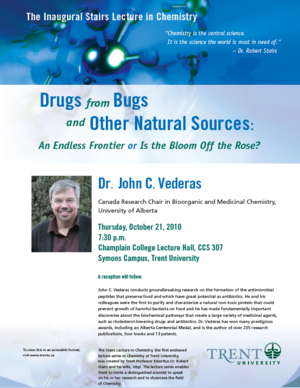
DR. JOHN C. VEDERAS
Canada Research Chair in Bioorganic and Medicinal Chemistry, University of Alberta
October 21, 2010
Dr. Vederas conducts groundbreaking research on the formation of the antimicrobial peptides that preserve food and which have great potential as antibiotics. He and his colleagues were the first to purify and characterize a natural non-toxic protein that could prevent growth of harmful bacteria on food and he has made fundamentally important discoveries about the biochemical pathways that create a large variety of medicinal agents, such as cholesterol-lowering drugs and antibiotics. Dr. Vederas has won many prestigious awards, including an Alberta Centennial Medal, and is the author of over 235 research publications, four books and 13 patents.
|